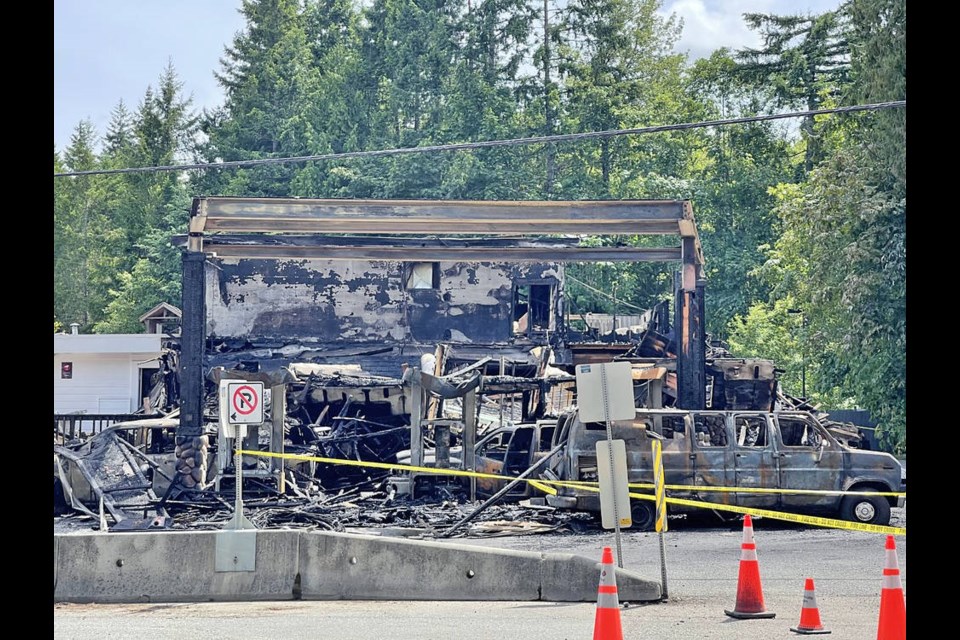A fire at a Whiskey Creek gas station on Thursday is a reminder for drivers of the inherent dangers of handling a flammable substance.
About 50 firefighters from nine fire departments battled the fire at the Co-op gas station on Thursday.
The blaze, reported to the Coombs-Hilliers Fire Department at 3:45 p.m., shut down Highway 4 in both directions for most of the afternoon. Crews were on site until about 10:20 p.m. attending to hot spots in the structure.
When firefighters arrived, the fire had spread to an overhead canopy and the front of a two-storey building housing a convenience store.
Lt. Theresa Benoit of the Coombs-Hilliers Fire Department said quick-thinking staff members activated the emergency shut-off for the fuel pumps. “They safely evacuated all staff and public, resulting in no injuries.”
She said the fire was challenging to access. As there were no fire hydrants at the location, crews had to draw water from 11 water tender apparatus.
The building sustained significant damage from the fire, which was isolated to one structure.
The fire is believed to have started with a vehicle at the fuel pump. While the exact cause remains under investigation, early indications are that it was accidental.
According to the National Fire Protection Association, there were almost 4,400 fires at service stations in the United States between 2014 through 2018, with about 20 per cent caused by the ignition of gasoline.
Gas stations operate under strict guidelines, said Capt. Carl Trepels, in the fire-prevention division of the Saanich Fire Department. Although there have been vehicles on fire at a gas station, he cannot recall a local gas station catching fire in his 19-year career.
Safety rules at gas stations include a requirement that pumps be protected against collision damage, have easily accessible fire extinguishers, have filler nozzles with an automatic shut-off valve and have an attendant with a clear view of the pumps and trained in operating an emergency shut-off switch.
“But you have to realize that things can happen and people do panic, so it’s important to have a comprehensive fire plan,” said Trepels.
He said that while the safeguards are comprehensive, human error can still cause fires.
People usually remember to turn off their vehicles and not smoke, but many aren’t aware of the dangers of static electricity, he said.
It’s hazardous to fill portable gasoline containers that are inside a car or the bed of a truck — especially trucks with a plastic bed liner. The flowing gasoline can create a static charge, and the insulating effect of the bed liner prevents the charge from grounding. The discharge to the grounded gasoline dispenser nozzle can cause a spark and ignite the gasoline.
As a result, it’s advisable to always place the gas can on the ground at a safe distance from the vehicle when it’s being filled.
Vehicle fires can also be the result of leaking vehicle fuel lines and gas tanks, said the owner of a local vehicle repair shop. “It’s not common around here, but sometimes you will see a vehicle from back east — somewhere where they use a lot of salt — with rust on the gas hoses,” said Doug Buchanan, owner of Dunsmuir Super Service.
He said that you may still find rusty gas tanks on older vehicles, but most modern cars and trucks are now equipped with plastic tanks, so it’s nowhere near the problem it once was.
Most vehicle owners are alerted to leaky fuel lines by the strong odour of fuel — or a telltale puddle — after the vehicle has been left parked overnight
He said spilled gasoline at a gas station is more likely to be from someone jamming an object, usually a gas filler cap, into the filler nozzle. Most nozzles require you to squeeze the handle to dispense fuel. Once you take your hand off the handle, the fuel stops.
All modern fuel filler nozzles in self-service stations have an auto-shut-off valve (nozzles at full-service stations have a hold-open device for the convenience of the attendants). Once the nozzle detects back-pressure, it switches off the fuel delivery.
But if the valve is faulty or fails, the fuel will continue to flow even after the tank is filled, resulting in a quantity of fuel on the ground and a potential for fire.
“It’s important to pay attention,” said Trepels.



